VABF curation
The Vienna Art Book Fair is pleased to host several exhibitions at this year’s event. Marlene Obermayer invited professionals in the field of art and culture to curate exhibitions on artists’ books, “publishing as artistic practice” and publications that utilized special distribution mechanisms.
Curated by: Annette Gilbert, Bernhard Cella, Christian Egger, David Jourdan, Franz Thalmair, Grudrun Ratzinger, Heimo Zobernig, Jan Steinbach, Johannes Porsch, Jürgen Dehm, Luca Lo Pinto, Moritz Grünke, Nicole Six/Paul Petritsch and Regine Ehleiter.
Locations
︎ SR 25 (Seminarraum / conference room 25), Ground Floor
︎ SR 27 (Seminarraum / conference room 27), Ground Floor
︎ Aula / Auditorium, Ground Floor
︎ FLUX 2, Level 2
︎ Aula, Ground Floor
︎ Tables A05, B08, D13, D25, F03, G18 and SR 24: Europapier / Paperinstallationsselected by Sandra Schmidt (Europapier)
︎ You’ll find more Paperinstallations on Level 2
Displayed paper: Sumo, Munken Kristall Rough, Munken Kristall, Marmor, Marmor Classy Covers, Leinenprägung, Leuchtplakat Orange, Mirror spiegelglanz, PUR COTON Baumwolle, Enduro Ice
with friendly support of Europapier
︎ Aula, Ground Floor
︎ Table D04: Risograph printed artists’ publications
curated by Moritz Grünke
︎ You’ll find the riso table next to Gloria Glitzer (D03)
Moritz Grünke presents an “selling exhibiton” of riso printed artists’ publications by Jul Godon, Anne Vagt, Caroline Paquita, Ben Duvall, Sergej Vutuc, Maxime Gambus, Maik Gräf, Matt Plezier, Zoran Pungercar, Jan Matthé, Lodret Vandret, Dogan Surek, Udo Kittelmann, Lisa Marei Schmidt, Plaf Nikolai, Dominique Hurth, Peter Sutherland, etc.
Gloria Glitzer is an artists group, an publisher, an avatar of the artists Franziska Brandt and Moritz Grünke. Founded in 2007, Gloria Glitzer develops, creates, and publishes artzines and artists’ books and understands publishing as artistic practice.
They also runs the Risograph printing and design studio We make it and hosts the Herbarium Riso, a public library dedicated to stencil printed artists’ publications.
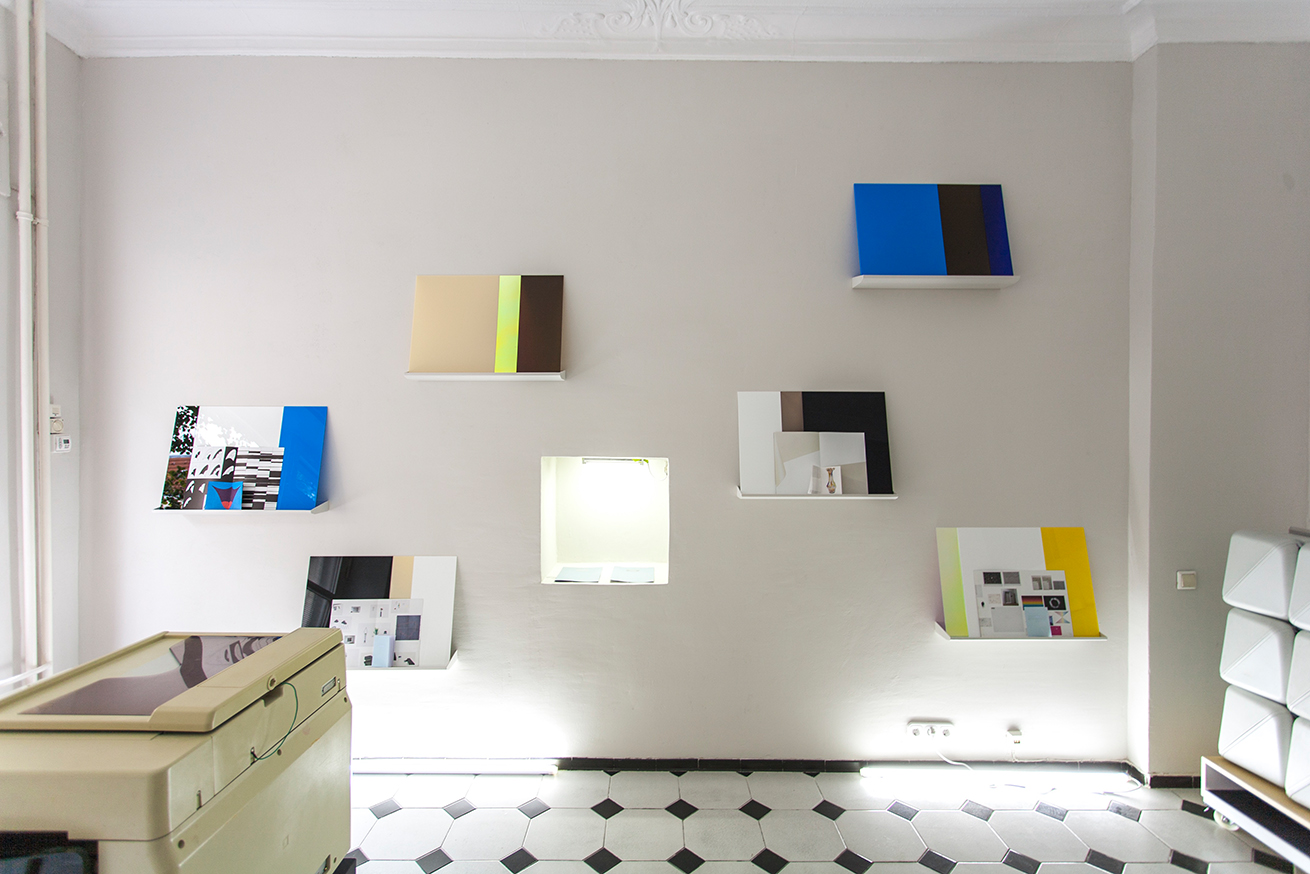
we-make.it
herbarium-riso.com
︎ Aula, Ground Floor
︎ Table C15: edcat.net art edition catalogue
curated by Jan Steinbach
︎ You’ll find the edcat table next to Edition Taube (C16)
edcat is the first open online catalogue and platform for art publications. It allows anyone to search a fast growing database of art books and editions and discover new art. The platform provides tools to manage a collection and a watchlist, sell and buy as well as add new information about publications to the database and interact with the community. edcat helps you to discover your next favorite art publications and to buy them directly form the creators. Thereby edcat is augmenting the visibility of international cultural productions and empowers independent publishing.
For the Vienna Art Book Fair, edcat presents a selection of recent examples of independent publishing and art books from the platform.

edcat.net
︎ SR 25, Ground Floor
︎ Re:Groups, Vienna Art Book Fair, Oct. 4-6, 2019
curated by Regine Ehleiter
In November 1969, the American art critic Lucy R. Lippard organized a small exhibition with serial photo-text works in the gallery of the School of Visual Arts in New York, titled “Groups.” About twenty-five artists followed a specific set of instructions she provided for the show (reproduced below). Among the participants were Robert Barry, Jonathan Borofsky, Douglas Huebler, Alex Katz, Sylvia Mangold, N.E. Thing Co., Adrian Piper and Lawrence Weiner. A few months later, in March 1970, Lippard selected half of the works for an eponymous “magazine exhibition” in the British journal Studio International. It was the first project of its kind in a mainstream art magazine. Yet because of layout issues, Lippard’s printed exhibition—unlike its imminent successor, Seth Siegelaub’s “July, August 1970”—was soon forgotten.
To celebrate “Groups” and to take it as a point of departure for reflection on how the conditions of production and display have changed over the last sixty years, I asked a group of contemporary artists to follow Lippard’s instructions again in 2019. Their new responses form the exhibition “Re: Groups” and were first on view in the Forum section of Camera Austria International magazine (no. 147, pp. 53–63). A second version of the same exhibition, featuring the artists’ prints, is now presented at the University of Applied Arts during the Vienna Art Book Fair.
Participating artists:
Maria Anwander, Anca Benera & Arnold Estefan, Natalie Czech, Philipp Grünewald, David Horvitz, Alwin Lay, Laida Lertxundi, Anika Libertore, Alina Schmuch, Katja Stuke & Oliver Sieber, Triin Tamm
Groups
Lucy R. Lippard
A. Photograph a group of five or more people in the same place, and approximately the same positions in relation to each other, once a day for one week. (No posing or gimmicks, no diversion from the conventional group photo taken for school yearbooks, Knights of Columbus annual picnics, etc.) The people need not wear the same clothes or pose exactly the same way each day, but the immediate impression should be of seven almost identical photographs incorporating chance variations.
B. Develop the photographs (having made note each day what people are wearing or something, so that when the prints come back, their chronological order can be established). Prints should be ordinary snapshot size.
C. Describe each photograph in writing, in detail. Simply say what is observed, but look closely. Type up the descriptions separately. Date each text and each photograph.
D. The photographs will be hung in a single horizontal line in one of the following orders (your choice):
1. Pictures with their texts below them in chronological order.
2. Pictures in chronological order, but texts scrambled, either randomly or systematically (your own system).
3. Texts in chronological order, but pictures scrambled.
4. Scramble the whole thing by system or at random (still noting dates of each text and photo) so that the time sequence is entirely broken, “illustration” and description diverge at times, coincide at times.
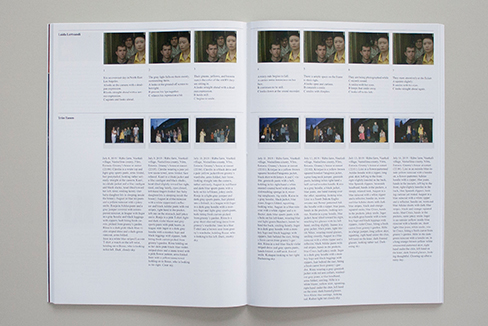
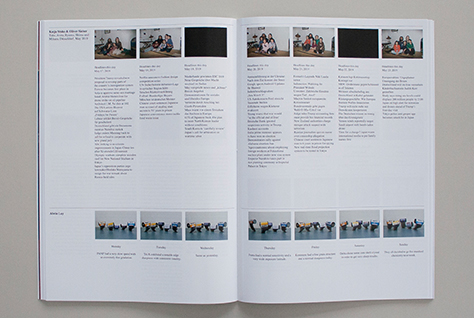
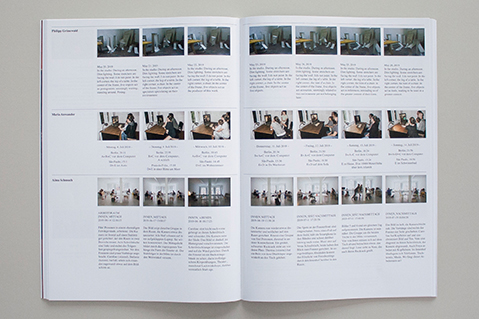

︎ On Saturday, October 05, 2019 at 3:00 pm, curator Regine Ehleiter will lead through the exhibition "Re: Groups", joined by the artist Alwin Lay.
Find the full program here
︎ SR 27, Ground Floor
︎ Three Star Books, Paris FR
curated by Melanie Scarciglia
Three Star Books produces books and editions with the finest contemporary artists. The term‚ "Artist's book" is interpreted loosely, as the final product often exceeds the physical and conceptual parameters of publishing.
threestarbooks.com
︎ SR 27, Ground Floor
︎ “Furthermore, I can predict with some certainty that one of these days a(n unauthorised) copy of the full text will find its way into circulation as a PDF file.”
curated by Franz Thalmair
Walter Benjamin, David Blamey & Brad Haylock, Marcel Broodthaers, Bernadette Corporation, Sean Dockray (ed. by Kristina Lee Podesva), Peter Downsbrough, Claire Fontaine, Kenneth Goldsmith, Dan Graham, Isabelle Graw (ed. by Isabelle Graw), Abbie Hoffman, Karl Holmqvist, David Horvitz, David Lamelas, Seth Price, The Serving Library (Francesca Bertolotti-Bailey, Stuart Bertolotti-Bailey, Vincenzo Latronico, David Reinfurt)
︎ SR 27, Ground Floor
︎ Artists’ Books by Heimo Zobernig
curated by Heimo Zobernig / presented by Georg Fritsch antiquarian bookstore
“There is something very beautiful about artists’ books. They provide an insight into the artists’ ways of thinking, turn conventional rules of design upside down and disturb our reading habits. Mostly, they are objects that exaggerate their usual forms. They are either very large or very small, very thick or very thin. Often, they constitute a challenge for their readers because they can be very heavy or do not fit onto the shelf, and the typography and/or design are so unconventional that occasionally they are simply illegible. Furthermore, they cause problems for the artists themselves, as they cannot be produced, disseminated or passed on without tremendous effort. Anyhow, artists’ books often prove that something beautiful can also be a nuisance.” Heimo Zobernig 2005
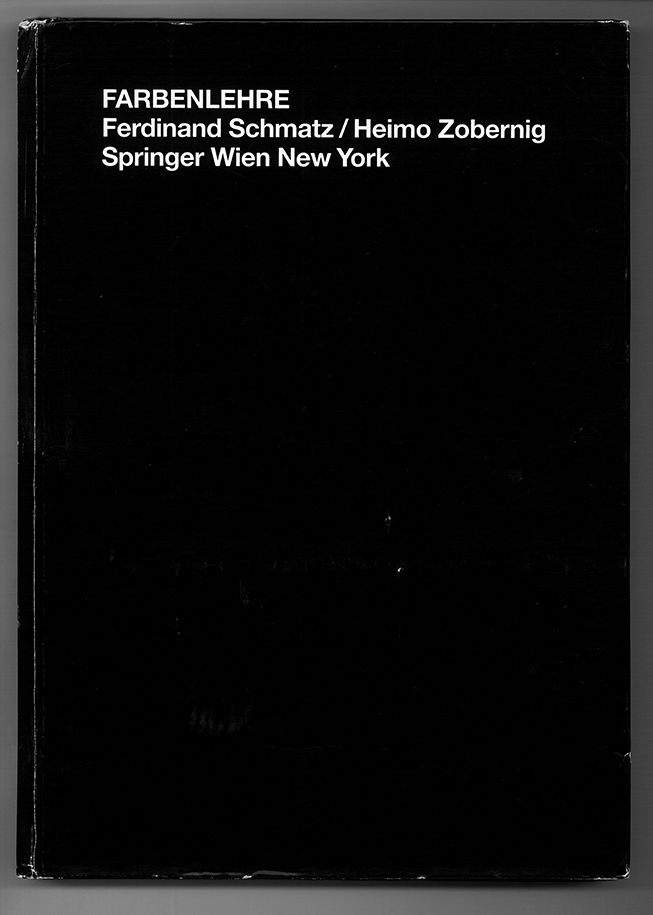
heimozobernig.com
The Georg Fritsch antiquarian bookstore originated from the bookstore Dr. Goldschmidt that was founded in 1958 in Döbling, Vienna. Since 1985, the antiquarian bookstore has been located at the Schönlaterngasse 7, at the House of the Basilisk, after the renovation of the gallery Basilisk (Lingens & Kettner) by Elsa Prochaska. We specialized in the documentation of avant-garde endeavors in the fields of art, literature, photography, and music. Artists’ books and folios by Martin Kippenberger, Dieter Roth, Jörg Schlick, Franz West, Heimo Zobernig i.a.
A list of 100 illustrated titles at a time is published monthly on AUSTRIADREI.AT.
selfritsch.at
︎ SR 27, Ground Floor
︎ Johannes Porsch / Documents
︎ The other Documents tables on the ground floor are placed in row A02, C12, D18, F02, F11 and H13
︎ FLUX 2, Level 2
︎ Empty cardboard six-pack holders, odds and ends, and collapsible cups
curated by David Jourdan
A personal selection of marginal publications, transitory printed matter, and a few other related things.
︎ FLUX 2, Level 2
︎ Out, Because, Between, Thrucurated by Christian Egger
Artist and Author Christian Egger’s "Out, Because, Between, Thru" is a nimble table made up of a lot of false starts. Collecting together, books, magazines and art publications, that are defining in his practice, it is presenting us with a disorientating narrative experience, a nubile aggregate of different issues, forms and viewpoints.
︎ FLUX 2, Level 2
︎ „des aller ‚istischen’ Kunstdezenniums“: Artists’ publications from the 1920s curated by Gudrun Ratzinger
„des aller ‚istischen’ Kunstdezenniums“ artists’ publications from the 1920s focuses on one of the many prehistories of contemporary publishing by artists. On view are printed works which were concerned with the dissemination of advanced art and which relied on the power of pictorial compositions. These "pictorial texts" are thus located at an important interface between art and the public and can be understood as "imaginary exhibitions" due to the large number of reproduced works of art.
Hans Arp, El Lissitzky (Hg.), Die Kunstismen, Erlenbach-Zürich, München u. Leipzig: Eugen Rentsch Verlag 1925 (Reprint: Lars Müller Publishers, 1990) ; Siegfried Giedion, Space, time and architecture: The growth of a new tradition, Cambridge, Mass.: Harvard Univ. Press, 1944 ; Lajos Kassák, Laszlo Moholy-Nagy (Hg.), Buch neuer Künstler, Wien: Ma, 1922 (Reprint: Lars Müller Publishers, 1991) ; El Lissitzky, Ilja Ehrenburg (Hg.), Vesc/Objet/Gegenstand, März/April bzw. Mai 1922, Berlin (Reprint: Lars Müller Publishers, 1993) ; André Malraux, Das imaginäre Museum, Baden-Baden : Klein, 1947.László Moholy-Nagy, Malerei, Photographie, Film, München : Langen 1925 ; Franz Roh und Jan Tschichold (Hg.), Foto-Auge. 76 Fotos der Zeit, Stuttgart: Wedekind, 1929 ; Kurt Schwitters und EL Lissitzky, Merz 8/9. Nasci, 1924 (Reprint: Lang, 1975). Union der Sozialistischen Sowjet-Republiken (Hg.), Katalog des Sowjet-Pavillons auf der Internationalen Presse-Ausstellung, Köln 1928 (Reprint: Wienand, 1981).

Reprints kindly supplied by
︎ FLUX 2, Level 2
︎ Queer Publishing. A family tree
curated by Bernhard Cella and Roland Fischer-Briand
Performative presentation with publications from the collection as well as the presentation of the poster edition for 1 Euro. The Queer Tree of Life maps the landscape of queer LGBTQ publishing between 1880 and 2019 in an international context. The selected examples focus on identity and image constructions of queer lifestyles. Fanzines, self-publishing, academic discourse, research, porn, and artist books are presented as pioneers of a non-heteronormative self-understanding.
Vienna 2019
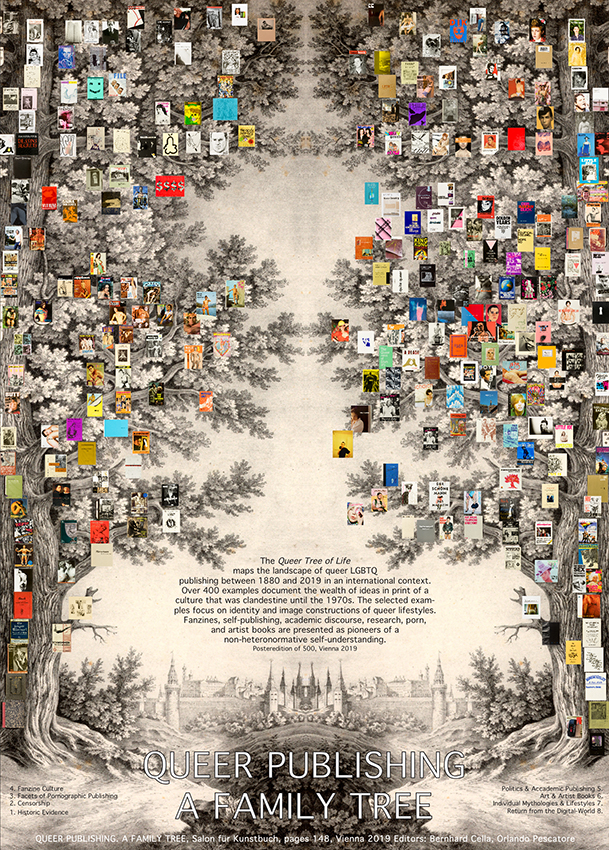
salon-fuer-kunstbuch.at
︎ FLUX 2, Level 2
︎ The Magazine as an Extended Space: Interfunktionen and Avalanche
curated by Jürgen Dehm
Art magazines such as Interfunktionen and Avalanche, founded in the 1960s and 1970s offered especially artists who were working outside the traditional art genres an extended platform for the presentation of their ideas and works – beyond the traditional exhibition formats. From the perspective “united in what is negated” the magazine Interfunktionen, founded in 1968 in Cologne, West Germany, focused on the forms of expression of a generation of artists on the move, who explicitly positioned themselves beyond painting. Avalanche, published from 1970 to 1976 by Willoughby Sharp and Liza Béar in New York, was primarily intended as a publication tool for – or in support of – conceptually or performatively working artists. The individual editions featured various pieces, but focused mostly on one artist’s personality, with a corresponding picture on the cover and a largely unedited interview inside the magazine.
︎ FLUX 2, Level 2
︎ Library of Artistic Print on Demand
curated by Annette Gilbert and Andreas Bülhoff
Contemporary experimental artists and writers who have adopted print-on-demand publishing praise the method’s low financial risk, creative autonomy, and independence from trade publishers. They embrace it as a means of self-empowerment and democratization—although (or, maybe, precisely because) it has been discredited by the literary establishment as a vanity enterprise and by book lovers and designers irritated by its low production values. Drawing on some of the most notable examples of the genre, this lecture will show how POD facilitates an astonishing variety of forms and aesthetic approaches and how it functions as a critical media practice that continues avant-garde, underground, and counterculture traditions and also responds to our post-digital age and compels us to re-conceptualize our understanding of the book and publishing.
Print-on-demand is a new production method based on digital print that has revolutionized the book world. Allowing for very small print runs down to one single copy the availability of book titles no longer requires a physical stock—in contrast to traditional print runs. This has fundamental effects on the production of printed matter and its contents. Our collection of artistic print-on-demand publications will grow through curatorial acquisition and artist's/author's contributions. It will be preserved in future years in a leading German library. It will be an important resource for the study of print-based experimental publishing, art and literature in the post-digital era. http://apod.li/
︎ FLUX 2, Level 2
︎ Artists’ Books
curated by Nicole Six / Paul Petritsch
Since 1997 they have been working together on performances, films, photographs, sculptures, displays and projects in public space.
Artists’ books: Lost and Found, Aussicht kann durch Ladung verstellt sein, Raum für 17 Minuten 6’23’’, Atlas, Fotoarchiv 05.10.2008-16.02.2007, Fotoarchiv 21.01.2007-07.09.2005, Fotoarchiv 16.08.2005-04.08.2004, Fotoarchiv 06.06.2004-15.02.2001

six-petritsch.com
︎ FLUX 2, Level 2
︎ The Camera Never Lies (Even When I Do). An homage to CS Leigh (1964-2016)
curated by Luca Lo Pinto
Christian Leigh has been a kind of mythical and at the same time underestimated figure of the art scene of the late 1980s and early nineties. There are very few pictures of him and of his shows though one can sometimes find his generous exhibition catalogues. Someone defined him as the most flamboyant of the independent curators who had risen to prominence with the bull market of the 1980s. For a seven-year run beginning in 1987, Christian Leigh was one of the most visible and ambitious independent curators in the international art world. Then he walked away leaving very few traces. Over several years in the nineties he curated a group of prominent shows, all titled after Hitchcock films: Spellbound, Vertigo, Rope and Psycho. Almost a year later he left the art world to begin a new career as filmmaker under a slightly different name: CS Leigh. He directed the films Far from China, Process, See you at Regis Debray, American Widow and I was Jack Goldstein featuring collaborations with Marianne Faithfull, Suede, John Cale, Leos Carax, Guillaume Dustan, Humbert Balsan, Cat Power, Katja Golubeva and Thurston Moore, among others.
I had the opportunity to meet Christian several times in London and talk about his life and work. In 2014 we started to work on an exhibition to take place at Kunsthalle Wien in 2016. The show never happened. Christian passed away in 2016. I decided to pay him a small homage in the same city where his last show was supposed to take place by presenting a selection of material related to his practice as exhibition curator, editor and filmmaker. Luca Lo Pinto 2019